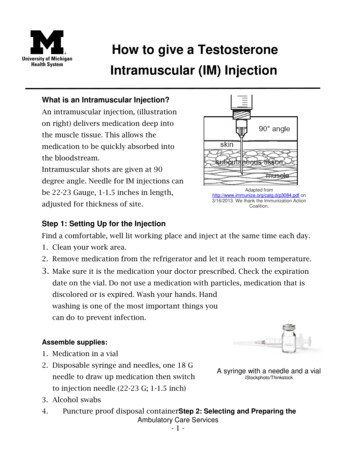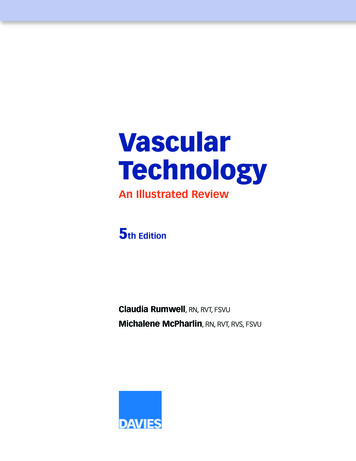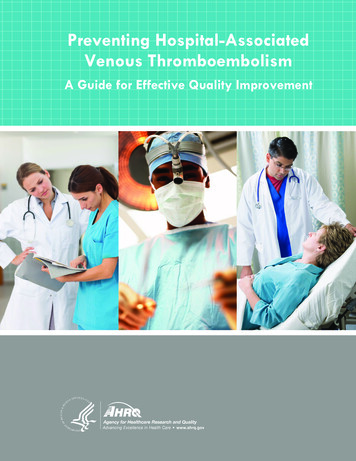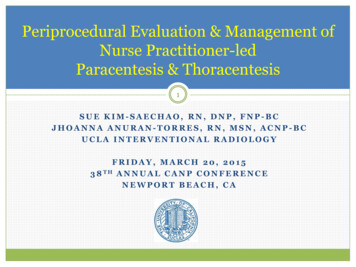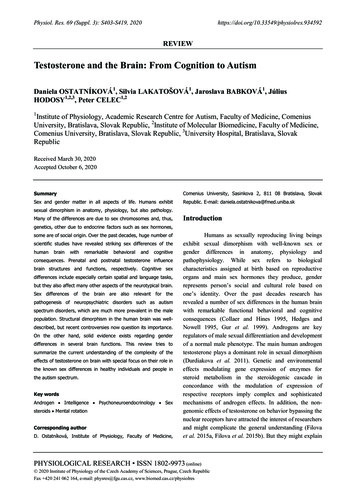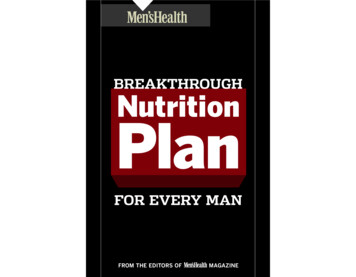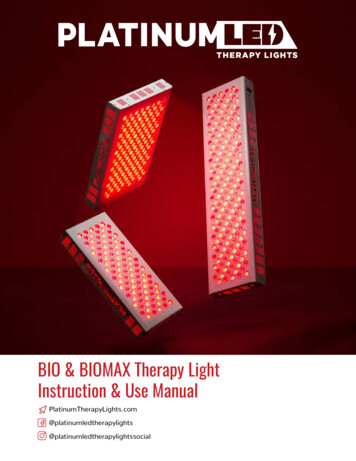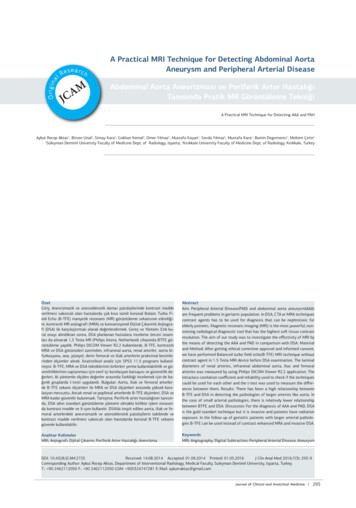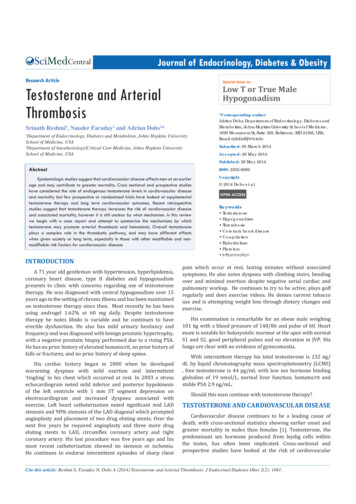
Transcription
CentralJournal of Endocrinology, Diabetes & ObesityResearch ArticleSpecial Issue onLow T or True MaleHypogonadismTestosterone and ArterialThrombosis*Corresponding authorAdrian Dobs, Department of Endocrinology, Diabetes andMetabolism, Johns Hopkins University School of Medicine,1830 Monument St, Suite 328, Baltimore, MD 21205, USA,Email:Srinath Reshmi1, Nauder Faraday2 and Adrian Dobs1*1Department of Endocrinology, Diabetes and Metabolism, Johns Hopkins UniversitySchool of Medicine, USA2Department of Anesthesiology/Critical Care Medicine, Johns Hopkins UniversitySchool of Medicine, USASubmitted: 30 March 2014Accepted: 26 May 2014Published: 28 May 2014AbstractISSN: 2333-6692Epidemiologic studies suggest that cardiovascular disease affects men at an earlierage and may contribute to greater mortality. Cross sectional and prospective studieshave considered the role of endogenous testosterone levels in cardiovascular diseaseand mortality but few prospective or randomized trials have looked at supplementaltestosterone therapy and long term cardiovascular outcomes. Recent retrospectivestudies suggest that testosterone therapy increases the risk of cardiovascular diseaseand associated mortality, however it is still unclear by what mechanism. In this reviewwe begin with a case report and attempt to summarize the mechanisms by whichtestosterone may promote arterial thrombosis and hemostasis. Overall testosteroneplays a complex role in the thrombotic pathway, and may have different effectswhen given acutely or long term, especially in those with other modifiable and nonmodifiable risk factors for cardiovascular disease.INTRODUCTIONA 71 year old gentleman with hypertension, hyperlipidemia,coronary heart disease, type II diabetes and hypogonadismpresents to clinic with concerns regarding use of testosteronetherapy. He was diagnosed with central hypogonadism over 15years ago in the setting of chronic illness and has been maintainedon testosterone therapy since then. Most recently he has beenusing androgel 1.62% at 60 mg daily. Despite testosteronetherapy he notes libido is variable and he continues to haveerectile dysfunction. He also has mild urinary hesitancy andfrequency and was diagnosed with benign prostatic hypertrophy,with a negative prostatic biopsy performed due to a rising PSA.He has no prior history of elevated hematocrit, no prior history offalls or fractures, and no prior history of sleep apnea.His cardiac history began in 2000 when he developedworsening dyspnea with mild exertion and intermittent‘tingling’ in his chest which occurred at rest. In 2003 a stressechocardiogram noted mild inferior and posterior hypokinesisof the left ventricle with 1 mm ST segment depression onelectrocardiogram and increased dyspnea associated withexercise. Left heart catheterization noted significant mid LADstenosis and 90% stenosis of the LAD diagonal which promptedangioplasty and placement of two drug eluting stents. Over thenext five years he required angioplasty and three more drugeluting stents to LAD, circumflex coronary artery and rightcoronary artery. His last procedure was five years ago and hismost recent catheterization showed no stenosis or ischemia.He continues to endorse intermittent episodes of sharp chestCopyright 2014 Dobs et al.OPEN ACCESSKeywords Testosterone Hypogonadism Thrombosis Coronary heart disease Coagulation Endothelium Platelets Inflammationpain which occur at rest, lasting minutes without associatedsymptoms. He also notes dyspnea with climbing stairs, bendingover and minimal exertion despite negative serial cardiac andpulmonary workup. He continues to try to be active, plays golfregularly and does exercise videos. He denies current tobaccouse and is attempting weight loss through dietary changes andexercise.His examination is remarkable for an obese male weighing101 kg with a blood pressure of 140/86 and pulse of 60. Heartexam is notable for holosystolic murmur at the apex with normalS1 and S2, good peripheral pulses and no elevation in JVP. Hislungs are clear with no evidence of gynecomastia.With intermittent therapy his total testosterone is 232 ng/dL by liquid chromatography mass spectrophotometry (LCMS), free testosterone is 44 pg/mL with low sex hormone bindingglobulins of 19 nmol/L, normal liver function, hematocrit andstable PSA 2.9 ng/mL.Should this man continue with testosterone therapy?TESTOSTERONE AND CARDIOVASCULAR DISEASECardiovascular disease continues to be a leading cause ofdeath, with cross-sectional statistics showing earlier onset andgreater mortality in males than females [1]. Testosterone, thepredominant sex hormone produced from leydig cells withinthe testes, has often been implicated. Cross-sectional andprospective studies have looked at the risk of cardiovascularCite this article: Reshmi S, Faraday N, Dobs A (2014) Testosterone and Arterial Thrombosis. J Endocrinol Diabetes Obes 2(2): 1041.
Dobs et al. (2014)Email:Centraldisease and mortality related to endogenous testosteronelevels and after supplemental testosterone therapy, with fewrandomized trials of long term data. With regards to endogenoustestosterone, meta-analyses of prior prospective studies showthat low testosterone levels are modestly associated withincreased all-cause and cardiovascular disease mortality [2], aswell as incident cardiovascular disease [3] after controlling forother cardiovascular risk factors. This may partly be explainedby the excess association of low testosterone with obesity,diabetes and other chronic morbidities [4]. Recent studies alsoimplicate high endogenous testosterone levels with all-causemortality and ischemic cardiovascular mortality [5]. Possibleexplanations include that high endogeneous testosterone levelsraise hemoglobin and hematocrit, cause fluid and salt retention,and alter the balance in lipoproteins, all which may contribute tocardiovascular disease, heart failure and ischemic stroke. Thereis heterogeneity in prospective trials of exogenous testosteronesupplementation, with limited focus on cardiovascular events asa primary outcome. In 2010 a randomized trial of testosteronesupplementation in elderly men with hypogonadism and limitedmobility was discontinued due to excess cardiovascular events inthe treatment group [4]. This risk was further emphasized by anobservational study using a national health-care database whichsuggested increased mortality particularly in the elderly and inyounger men with prior coronary heart disease and within thefirst 90 days of filling a testosterone prescription [6].Given the recent growth in the testosterone treatment optionsand controversy regarding cardiovascular risk associated withsupplemental testosterone therapy, the timing is ideal to furtherinvestigate the mechanism by which testosterone could result incoronary heart disease. In this review we investigate mechanismsby which testosterone may promote arterial thrombosis, thuscontributing to clinical cardiac events. A review of the literaturewas conducted using search terms ‘low testosterone’, ‘platelets’,‘testosterone replacement’, ‘blood coagulation’, ‘clotting’,‘endothelium’, ‘inflammation’, ‘cardiovascular disease’.T and endotheliumVascular endothelium plays a crucial role in maintainingvessel growth dilation, tone, and mediating the inflammatory andcoagulation pathways. Angiogenesis contributes to maintainingequilibrium. While one study showed that endothelial progenitorcells are more dependent on estradiol rather than androgens invivo and in vitro [7], another study showed increased activity ofendothelial progenitor cells in vitro after injection of physiologicdoses of a synthetic androgen [8]. In studies of vascular plaqueformation, testosterone administration in physiologic doseswas shown to reduce neo-intimal plaque progression in animalmodels in vitro, which is felt to be secondary to up-regulation ofthe androgen receptor in the vessel wall [9]. Impaired coronaryvasodilation and reactivity has also been shown to be a predictorof future cardiovascular events [10]. Testosterone infusion atphysiologic and supra-physiologic doses has been shown topromote vasodilation both in vivo and in vitro [11], as well aspromote coronary vasodilation and increased coronary diameterwhen infused short term in subjects with cardiovascular disease[12]. Brachial artery reactivity, a correlate of coronary arteryfunction, as measured by flow mediated dilation at the brachialJ Endocrinol Diabetes Obes 2(2): 1041 (2014)artery, was negatively correlated with endogenous total and freetestosterone in males [13]. Studies of supplemental testosteronein hypogonadal men have shown positive results on flowmediated dilation, with one study showing improvement inbrachial artery reactivity in subjects with coronary heart diseaseafter 12 weeks of therapy with oral testosterone [14]. These datasuggest vasodilatory effects of testosterone both when givenshort and long term.Testosterone and plateletsPlatelets play a key role in thrombus formation throughadhesion to the vascular wall, aggregation, and stimulation ofcoagulation through release of metabolites such as thromboxaneA2 which further promotes platelet activity and vascular musclecontraction. In vitro studies in animal models suggest thattestosterone deficiency is associated with decreased plateletaggregation and thromboxane A2 receptor density, withtestosterone therapy improving platelet activity and thromboxaneA2 receptor density [15]. In a randomized blinded placebocontrolled study of healthy young men, testosterone therapy byinjection twice at physiologic doses two weeks apart was shownto increase platelet aggregation activity and thromboxane A2receptor density with a return to baseline within four weeks oftherapy administration [16]. The G coupled protein receptorP2Y12 on the platelet surface also plays an important role inplatelet aggregation. In a study using a human megakaryocyticcell line, administration of testosterone in culture resulted inincreased gene expression of P2Y12, suggesting another prothrombotic mechanism [17]. In contrast nitric oxide has beenshown to play an important role in vascular vasodilation andregulating hemostasis. In human umbilical vein endothelialcells, testosterone exposure at physiologic concentrations incell culture resulted in increased nitric oxide production andnitric oxide synthase activity, which stopped with exposure tosupraphysiologic concentrations of testosterone [18]. Similarlyin animal studies with rat aortic endothelial cells, testosteroneadministration in vitro resulted in increased nitric oxideproduction and reduced platelet aggregation [19]. Thus, bothanimal and human data suggest a mixed effect of testosterone onplatelet activity and function.T and coagulationCoagulation follows platelet stimulation with tissue factorinitiating the pathway leading to thrombin formation. Priorstudies have shown increased cardiovascular risk associatedwith greater levels of pro-thrombotic proteins factor VII andfibrinogen [20]. Low testosterone has also been associated withhigher levels of factor VII and fibrinogen cross-sectionally aftercontrolling for age, obesity and other metabolic parameters [21].Case control studies from Norway in elderly males have shownthose with low testosterone have lower ex vivo plasma levels ofthe inhibitor protein of tissue factor called tissue factor pathwayinhibitor(TFPI) as well as a more rapid initiation of coagulation[22]. A follow up placebo controlled interventional study inelderly men with low testosterone given replacement therapywith multiple injections over one year showed no difference inlevels of TFPI, activated factor VII or in coagulation time despitenormalization in testosterone levels [23]. Further analysissuggests that this may have been due to inappropriate timing of2/7
Dobs et al. (2014)Email:Centrallab assays with testosterone administration, due to endothelialchanges with aging or differences between short term and longterm effects of testosterone [24].Testosterone has also been seen to promote coagulation byaffecting proteins involved in the fibrinolytic pathway, which isinitiated by plasmin, stimulated by tissue plasminogen activator(tPA), and inhibited by plasminogen activator inhibitor-1(PAI-1)and plasminogen activator inhibitor-2(PAI-2). First discoveredin 1962 [25], cross sectional studies have shown an associationbetween lower endogeneous testosterone and greater levelsof (PAI-I) in subjects with coronary artery disease, suggestingincreased cardiovascular risk from reduced fibrinolysis [26].This inverse association between endogenous testosterone levelsand PAI-1 was also seen in obese patients and those with greatercentral obesity compared with healthy controls [21], and in menwith newly diagnosed hyperlipidemia [27]. In cell culture studiesusing human umbilical vein endothelial cells, physiologic dosingof testosterone stimulated tissue plasminogen activator (tPA)and decreased PAI-1 production [28]. Prospective interventionalstudies in healthy men have shown a reduction in fibrinolyticproteins with administration of testosterone metabolite DHEA orwith other anabolic androgens [24]. In healthy men attemptingto increase fertility, testosterone administered by injection over52 weeks was associated with an initial fall in PAI-1, protein Cprotein S with return to baseline over the course of treatment,with no changes in tPA over the course of therapy [29]. Ina randomized, double blinded, placebo controlled study ofmen with stable coronary heart disease; testosterone therapyadministered in the form of transdermal patch resulted in nochanges in plasma levels of fibrinogen, tPA or PAI-1 over greaterthan three months of therapy [30]. Overall the discrepanciesobserved in testosterone studies may reflect differences inthe age of subjects, different formulations of testosterone withphysiologic and supra-physiologic dosing, and differences induration of therapy.T and inflammationChronic inflammation is felt to play a role in the developmentand progression of atherosclerosis with inflammatory markerssuch as CRP and ESR implicated as predictors of coronary heartdisease [31]. Inflammatory cytokines such as IL-1, IL-6, TNFalpha also help propagate the development of atherosclerosisand are associated with increased cardiovascular risk [32,33]. Invivo animal studies have shown that inflammatory interleukincytokines are elevated in androgen deficiency [34]. Cell culturestudies also show that incubation with testosterone reducedinflammatory cytokine TNFα production in vascular endotheliumand other cell lines [35] and stimulated anti-inflammatorycytokine IL-10 production [36].Human studies have shown elevated inflammatory cytokinesin young hypogonadal untreated males without metabolic diseaseor cardiovascular disease, suggesting a mechanism for futureatherosclerosis [37]. In males with stable coronary artery diseaseand without myocardial infarction, pro-inflammatory IL-1β levelswere elevated in hypogonadal versus eugonadal subjects [38]. Arandomized placebo controlled cross-over intervention basedtrial in hypogonadal men showed a reduction in TNFα and IL-1after one month of injectable testosterone therapy compared toJ Endocrinol Diabetes Obes 2(2): 1041 (2014)placebo, with subgroup analysis showing significant reductiononly in TNFα among subjects with coronary heart disease [39].DISCUSSION AND CONCLUSIONIn the search for risk factors associated with cardiovascular disease incidence and mortality in men, recent studies haveimplicated both endogenous testosterone levels as well as supplemental testosterone therapy. Long term data is limited andfew intervention based trials have focused on cardiovascularoutcomes. In this review we investigated testosterone’s effecton various mediators in the thrombotic pathway, and considered studies looking at endogeneous testosterone and/or withsupplemental testosterone. Despite heterogeneity among studies, it appears that testosterone plays a role at all levels in thethrombotic pathway, as summarized in Table 1. At the level ofvascular endothelium, testosterone administration appears to beanti-thrombotic with in vitro studies showing increased activityof endothelial progenitor cells [8], and both in vitro and humanstudies showing vascular vasodilation after acute or long termtreatment [11,12,14]. Testosterone therapy appears to have amixed effect on platelets, with in vitro and human studies showing increased thromboxane A2 receptor density and gene expression of P2Y12 which promote platelet activity and aggregation[16,17], and in vitro studies also showing increased nitric oxideproduction which reduces platelet activity [18,19]. With regardsto the coagulation cascade, androgen deficiency is associatedwith increased pro-thrombotic factors [21,22] and increasedinhibitors of fibrinolysis [26], but testosterone therapy does notappear to change the balance in coagulation proteins [23] or thebalance in factors involved in fibrinolysis when given for longerduration [30,31]. Studies in inflammation do show that androgendeficiency is associated with elevated inflammatory cytokines[34,38], suggesting a pro-thrombotic mechanism in those untreated, while a therapeutic trial over one month in men withsymptomatic androgen deficiency showed a reduction in inflammatory cytokines [39]. Taken in sum these studies suggest therole of testosterone on the vasculature is mixed. It is difficult tospecify the weight of each of these mediators in the pathogenesisof atherothrombotic events.It is also possible that testosterone’s effect on the vasculaturemay be confounded by other modifiable and non-modifiablefactors including age, BMI, lifestyle, and other chroniccomorbidities [4]. Despite attempts to adjust for such factors inexperimental and prospective studies, it is hard to assess whichfactors are downstream effects of the testosterone level versuswhich are distinct mediators in the atherothrombotic pathway.One limitation in this analysis is that in vitro and in vivo analysismay not always translate into similar results in human studies.Another difficulty is the use of different reference values fortestosterone and different assays in different studies. Priorimmuno-assays are now replaced by liquid chromatographymass spectrophotometry(LCMS), which make comparisondifficult. Another difficulty in assessing the effect of testosteroneon thrombosis is that testosterone can be converted via5α-reductase to dihydrotestosterone or aromatized to estradiol.Both of these testosterone end products may have differentialeffects on various mediators associated with thrombosis. Lastlymany of these studies included here are non-randomized, with3/7
Dobs et al. (2014)Email:CentralTable 1: Testosterone’s impact on various mediators of thrombosis.Pro-thrombotic mechanismsAnti-thrombotic etsInflammation-Low T associated with increased factor VII, fibrinogen[21], lower TFPI [22]-Low T associated with greater PAI-1 levels [26]- T therapy may increase aggregation and thromboxaneA2 receptor density [16]-T therapy promotes P2Y12 receptor expression invitro [17]-Low T associated with elevated interleukins in vivo inanimal models [34]-Low T associated with elevated IL-1β in hypogonadalmen [38]small numbers of subjects, and limited long term follow up.In returning to our initial case, we presented a hypogonadalmale on testosterone for many years who had progression ofcoronary heart disease while on therapy. Despite intensiveinterventional and medication based therapy he still experiencedangina type symptoms. And despite chronic testosterone therapyour patient did not notice a difference in libido or well being.Review of the literature suggests that testosterone has a complexeffect on the pathophysiology of thrombosis and does not clearlysupport continuing or stopping therapy. In such a situation, adiscussion is required between the clinician and patient aboutthe specific risks and benefits of continuing testosterone therapy.Testosterone therapy may be continued with close monitoringof symptoms. Patients should also know that further research isneeded to assess the role that testosterone plays in promotingarterial thrombosis, especially in considering those who mayrequire long term testosterone replacement therapy.REFERENCES1. Murphy Sl, Xu J, Kochanek KD. Deaths: Final data for 2010. Natl VitalStat Rep. 2013; 61.2. Araujo AB, Dixon JM, Suarez EA, Murad MH, Guey LT, Wittert GA.Clinical review: Endogenous testosterone and mortality in men: asystematic review and meta-analysis. J Clin Endocrinol Metab. 2011;96: 3007-3019.3. Ruige JB, Mahmoud AM, De Bacquer D, Kaufman JM. Endogenoustestosterone and cardiovascular disease in healthy men: a metaanalysis. Heart. 2011; 97: 870-875.4. Ruige JB, Ouwens DM, Kaufman JM. Beneficial and adverse effects oftestosterone on the cardiovascular system in men. J Clin EndocrinolMetab. 2013; 98: 4300-4310.5. Yeap BB, Alfonso H, Chubb SA, Handelsman DJ, Hankey GJ, AlmeidaOP, et al. In older men an optimal plasma testosterone is associatedwith reduced all-cause mortality and higher dihydrotestosterone withreduced ischemic heart disease mortality, while estradiol levels do notpredict mortality. J Clin Endocrinol Metab. 2014; 99: E9-18.6. Finkle WD, Greenland S, Ridgeway GK, Adams JL, Frasco MA, CookMB, et al. Increased risk of non-fatal myocardial infarction followingJ Endocrinol Diabetes Obes 2(2): 1041 (2014)-May increase activity of endothelial progenitor cells invitro [8]-May reduce progression of plaque formation in animalmodels [9]-T therapy promotes coronary vasodilation, reducesbrachial artery reactivity [14]-T therapy stimulated tPA and reduced PAI-1 levels [28]-T therapy promotes nitric oxide production in vitro[18,19]-T infusion reduced TNFα in endothelial cells in vitro[36]-T therapy reduced TNFα and IL-1 in hypogonadalmales [39]testosterone therapy prescription in men. PLoS One. 2014; 9: e85805.7. Fadini GP, Albiero M, Cignarella A, Bolego C, Pinna C, Boscaro E, et al.Effects of androgens on endothelial progenitor cells in vitro and invivo. Clin Sci (Lond). 2009; 117: 355-364.8. Foresta C, Zuccarello D, De Toni L, Garolla A, Caretta N, FerlinA. Androgens stimulate endothelial progenitor cells through anandrogen receptor-mediated pathway. Clin Endocrinol (Oxf). 2008;68: 284-289.9. Hanke H, Lenz C, Hess B, Spindler KD, Weidemann W. Effect oftestosterone on plaque development and androgen receptorexpression in the arterial vessel wall. Circulation. 2001; 103: 13821385.10. Schächinger V, Britten MB, Zeiher AM. Prognostic impact of coronaryvasodilator dysfunction on adverse long-term outcome of coronaryheart disease. Circulation. 2000; 101: 1899-1906.11. Jones RD, Pugh PJ, Jones TH, Channer KS. The vasodilatory action oftestosterone: a potassium-channel opening or a calcium antagonisticaction? Br J Pharmacol. 2003; 138: 733-744.12. Webb CM, McNeill JG, Hayward CS, de Zeigler D, Collins P. Effects oftestosterone on coronary vasomotor regulation in men with coronaryheart disease. Circulation. 1999; 100: 1690-1696.13. Akishita M, Hashimoto M, Ohike Y, Ogawa S, Iijima K, Eto M, et al.Low testosterone level is an independent determinant of endothelialdysfunction in men. Hypertens Res. 2007; 30: 1029-1034.14. Kang SM, Jang Y, Kim J, Chung N, Cho SY, Chae JS, et al. Effect of oraladministration of testosterone on brachial arterial vasoreactivity inmen with coronary artery disease. Am J Cardiol. 2002; 89: 862-864.15. Matsuda K, Ruff A, Morinelli TA, Mathur RS, Halushka PV. Testosteroneincreases thromboxane A2 receptor density and responsiveness in rataortas and platelets. Am J Physiol 1994; 267: H887-893.16. Ajayi AA, Mathur R, Halushka PV. Testosterone increases humanplatelet thromboxane A2 receptor density and aggregation responses.Circulation. 1995; 91: 2742-2747.17. Lee SJ, Kwon JA, Cho SA, Jarrar YB, Shin JG. Effects of testosteroneand 17β-oestradiol on expression of the G protein-coupled receptorP2Y12 in megakaryocytic DAMI cells. Platelets. 2012; 23: 579-585.18. Goglia L, Tosi V, Sanchez AM, Flamini MI, Fu XD, Zullino S, et al.Endothelial regulation of eNOS, PAI-1 and t-PA by testosterone anddihydrotestosterone in vitro and in vivo. Mol Hum Reprod. 2010; 16:4/7
Dobs et al. (2014)Email:Central761-769.19. Cutini PH, Campelo AE, Agriello E, Sandoval MJ, Rauschemberger MB,Massheimer VL. The role of sex steroids on cellular events involvedin vascular disease. J Steroid Biochem Mol Biol. 2012; 132: 322-330.20. Meade TW, Mellows S, Brozovic M, Miller GJ, Chakrabarti RR, NorthWR, et al. Haemostatic function and ischaemic heart disease: principalresults of the Northwick Park Heart Study. Lancet. 1986; 2: 533-537.21. De Pergola G, De Mitrio V, Sciaraffia M, Pannacciulli N, Minenna A,Giorgino F, et al. Lower androgenicity is associated with higher plasmalevels of prothrombotic factors irrespective of age, obesity, body fatdistribution, and related metabolic parameters in men. Metabolism.1997; 46: 1287-1293.22. Agledahl I, Brodin E, Svartberg J, Hansen JB. Plasma free tissue factorpathway inhibitor (TFPI) levels and TF-induced thrombin generationex vivo in men with low testosterone levels. Thromb Haemost. 2009;101: 471-477.23. Agledahl I, Brodin E, Svartberg J, Hansen JB. Impact of long-termtestosterone treatment on plasma levels of free TFPI and TF-inducedthrombin generation ex vivo in elderly men with low testosteronelevels. Thromb Haemost. 2009; 102: 945-950.24. Brodin E, Vikan T, Hansen JB, Svartberg J. Testosterone, hemostasis,and cardiovascular diseases in men. Semin Thromb Hemost. 2011; 37:87-94.25. Fearnley GR, Chakrabarti R. Increase of blood fibrinolytic activity bytestosterone. Lancet. 1962; 2: 128-132.26. Phillips GB, Pinkernell BH, Jing TY. The association ofhypotestosteronemia with coronary artery disease in men.Arterioscler Thromb. 1994; 14: 701-706.27. Glueck CJ, Glueck HI, Stroop D, Speirs J, Hamer T, Tracy T. Endogenoustestosterone, fibrinolysis, and coronary heart disease risk inhyperlipidemic men. J Lab Clin Med. 1993; 122: 412-420.28. Jin H, Lin J, Fu L, Mei YF, Peng G, Tan X, et al. Physiological testosteronestimulates tissue plasminogen activator and tissue factor pathwayinhibitor and inhibits plasminogen activator inhibitor type 1 releasein endothelial cells. Biochem Cell Biol. 2007; 85: 246-251.29. Anderson RA, Ludlam CA, Wu FC. Haemostatic effects ofsupraphysiological levels of testosterone in normal men. ThrombHaemost. 1995; 74: 693-697.30. Smith AM, English KM, Malkin CJ, Jones RD, Jones TH, ChannerKS. Testosterone does not adversely affect fibrinogen or tissueplasminogen activator (tPA) and plasminogen activator inhibitor-1(PAI-1) levels in 46 men with chronic stable angina. Eur J Endocrinol.2005; 152: 285-291.31. Danesh J, Wheeler JG, Hirschfield GM, Eda S, Eiriksdottir G, Rumley A,et al. C-reactive protein and other circulating markers of inflammationin the prediction of coronary heart disease. N Engl J Med. 2004; 350:1387-1397.32. Hartman J, Frishman WH. Inflammation and atherosclerosis: a reviewof the role of interleukin-6 in the development of atherosclerosis andthe potential for targeted drug therapy. Cardiol Rev. 2014; 22: 147151.33. Kaptoge S, Seshasai SR, Gao P, Freitag DF, Butterworth AS, BorglykkeA, et al. Inflammatory cytokines and risk of coronary heart disease:new prospective study and updated meta-analysis. Eur Heart J. 2014;35: 578-589.34. Freeman BM, Mountain DJ, Brock TC, Chapman JR, Kirkpatrick SS,Freeman MB, et al. Low testosterone elevates interleukin familycytokines in a rodent model: a possible mechanism for the potentiationof vascular disease in androgen-deficient males. J Surg Res. 2014;S0022-4804: 00250-00259.35. Hatakeyama H, Nishizawa M, Nakagawa A, Nakano S, Kigoshi T, UchidaK. Testosterone inhibits tumor necrosis factor-alpha-induced vascularcell adhesion molecule-1 expression in human aortic endothelial cells.FEBS Lett. 2002; 530: 129-132.36. Liva SM, Voskuhl RR. Testosterone acts directly on CD4 T lymphocytesto increase IL-10 production. J Immunol. 2001; 167: 2060-2067.37. Bobjer J, Katrinaki M, Tsatsanis C, Lundberg Giwercman Y, GiwercmanA. Negative association between testosterone concentration andinflammatory markers in young men: a nested cross-sectional study.PLoS One. 2013 ; 8: e61466.38. Nettleship JE, Pugh PJ, Channer KS, Jones T, Jones RD. Inverserelationship between serum levels of interleukin-1beta andtestosterone in men with stable coronary artery disease. Horm MetabRes. 2007; 39: 366-371.39. Malkin CJ, Pugh PJ, Jones RD, Kapoor D, Channer KS, Jones TH. Theeffect of testosterone replacement on endogenous inflammatorycytokines and lipid profiles in hypogonadal men. J Clin EndocrinolMetab. 2004; 89: 3313-3318.Cite this articleReshmi S, Faraday N, Dobs A (2014) Testosterone and Arterial Thrombosis. J Endocrinol Diabetes Obes 2(2): 1041.J Endocrinol Diabetes Obes 2(2): 1041 (2014)5/7
Department of Endocrinology, Diabetes and Metabolism, Johns Hopkins University School of Medicine, USA. 2. Department of Anesthesiology/Critical Care Medicine, Johns Hopkins University . School of Medicine, USA. Abstract. Epidemiologic studies suggest that cardiovascular disease affects men a
